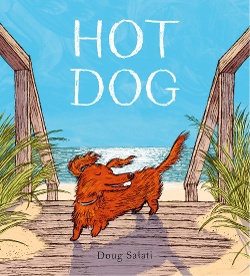Calling Caldecott chats with Doug Salati, winner of the 2023 Caldecott Medal for Hot Dog.

Doug Salati. Photo: Erin V. Carr
Doug Salati is the winner of the 2023 Randolph Caldecott Medal for Hot Dog (published by Knopf), which he also wrote. Julie Hakim Azzam interviewed Doug via email for Calling Caldecott.
Calling Caldecott: Congratulations on winning the Caldecott Award! Hot Dog was your debut as author and illustrator. How was the process of making this book different from previous experiences working as an illustrator with an author?
Doug Salati: Thank you so much, I really appreciate it. Illustrating an author’s manuscript gives you a solid point of departure. That is a good thing to have when I might veer off course while exploring how the pictures should be serving the text. Hot Dog’s process was a wobbly back and forth between drawing and writing, with the drawing usually leading the way. It was exciting and daunting to have to figure out the whole thing and have both the text and imagery grow, develop, and change together.
CC: How has winning the Caldecott changed how you feel about yourself as an author? As an illustrator? (Or you as both author and illustrator?)
DS: Drawing and writing is a humbling process. I feel very much the same, with all my pre-Caldecott strengths and weaknesses — no new superpowers in the studio, I am sorry to report! Recognition at any level for your work is always encouraging. Receiving the medal absolutely did change my knowledge, awareness and appreciation for the many parts of the publishing, library, and independent bookstore worlds. It has been an education of its own. I am in awe of, and very grateful for, the reach and exposure it has given Hot Dog.
CC: Your illustrations in Hot Dog capture something essential and immediately recognizable about the life of dogs in your attention to body language, and eye and facial expressions. It’s amazing, really! I read this and think of how my dog gives me that same look, or hangs her head when she’s tired and refuses to walk anymore and we’re in the middle of the road. What do you look at in order to make such spot-on, expressive illustrations?
DS: That is so fun to hear, thank you. Living in the place that inspired the setting of the book was ideal for observing and translating details that I think gave it a lot of life. The pictures grew out of many years of people and dog watching here in New York City. Sometimes it is a real show of emotions on the sidewalk. I was also lucky to have met a few dachshunds — Charlie, Lou & Ted — who made themselves available to model.
CC: I’m sure the last year has been full of visits to schools, libraries, and bookshops where you engage with young fans of your work. What do young readers notice or share about Hot Dog that most surprised and/or delighted you?

DS: I did get a few fantastic inquiries from school librarians and teachers who had discussions with their kids in regards to why some of the characters in the city scenes are "see-through" and "not colored in." Some students thought this was reflective of the story being told from the dog's perspective, so anything outside its sidewalk-level field of vision would be sketchy or blurry. Another interpretation was that some of the city characters were outlined to show they were "melting away" because of the summer heat. Some excellent pictorial analysis!
CC: Let’s nerd out on your artistic process for a minute. In your acceptance speech, you say that “an artist does not simply spring forth, fully formed...there are notes, dummies, drafts, revisions, preliminary sketches, final art.” Rowboat Watkins’s profile of you acknowledges that the final outcome of that process is “final illustrations that look so effortless they seem to materialize on the page before our very eyes.” How did you sustain yourself and keep going through this process that must have been nonlinear and sometimes frustrating? What did you do, or tell yourself to keep motivated and engaged?
DS: Oh, that Rowboat. An external, fresh perspective from friends, studio mates, and my editor and art director always helped to find clarity or consider solving a weaker area in a new way. Sometimes I needed to get out of the studio and walk around the city for more reference. Frustration usually comes from my trying to figure out too much, too fast, and solve it all inside my head. Possible solutions always come from breaking the problem down, sketching it out, and seeing how it actually works on the page. All I know how to do is repeat that process until enough pieces of the puzzle are resolved and the book starts to lead you to the next step.
CC: In your acceptance speech, you pay homage to previous Caldecott awardees whose work “defined the visual vocabulary” of your childhood. That was so eloquently put (and is no doubt quite a responsibility to take on now that you have the award!). What do you think Hot Dog has added to that visual vocabulary?
DS: The larger the range of that visual vocabulary, the better for readers. I do think my personal taste in the art I like today was first formed by those picture books and probably the practice of paying attention, too. I don’t know if I can say what Hot Dog has added. I hope the drawings allow for the reader to feel connected to the same range of emotions that the characters are experiencing. I hope the book, as a whole, delights readers enough to be picked up again and that it holds up a high standard of craft in terms of picture book making.
CC: Hot Dog works with contrasts on so many levels, from hot to cool, city and beach, enclosed and open, not to mention the use of color, the positioning of the panels that move from vertical to horizontal. I could go on and on! And every time I read it, I notice something new. Are these things conscious and planned, or do they intuitively happen?
DS: If you could see the sizable stack of book dummies and mock-ups and variations and revisions, then I think you’d feel the answer was solidly in the “conscious and planned” category. Those contrasts were a lot of fun to identify and work with. It was a slow build to figure out the strongest way I could get the reader to feel those juxtapositions, both in bold and subtle ways.
CC: How are you balancing the increased demands on your time as the Caldecott winner with future project deadlines or artistic desires? Is there a different cadence to your days or your weeks now that you’ve won the Caldecott? How have you managed, resisted, or integrated these demands and changes?
DS: The year rushed by and I kept up as best I could. I’ve had a tremendous amount of support and guidance at every turn from the Random House Children's Book teams in the school and library, marketing, publicity, and production departments, along with my editor and art director. Attending book festivals and meeting authors and illustrators I’ve long admired was thrilling. Visiting new bookstores and drawing together with students was a big highlight. I have several new and exciting projects that are waiting for me; I’m looking forward to re-immersing myself in the studio.

RELATED
ALREADY A SUBSCRIBER? LOG IN
We are currently offering this content for free. Sign up now to activate your personal profile, where you can save articles for future viewing.








Add Comment :-
Be the first reader to comment.
Comment Policy: